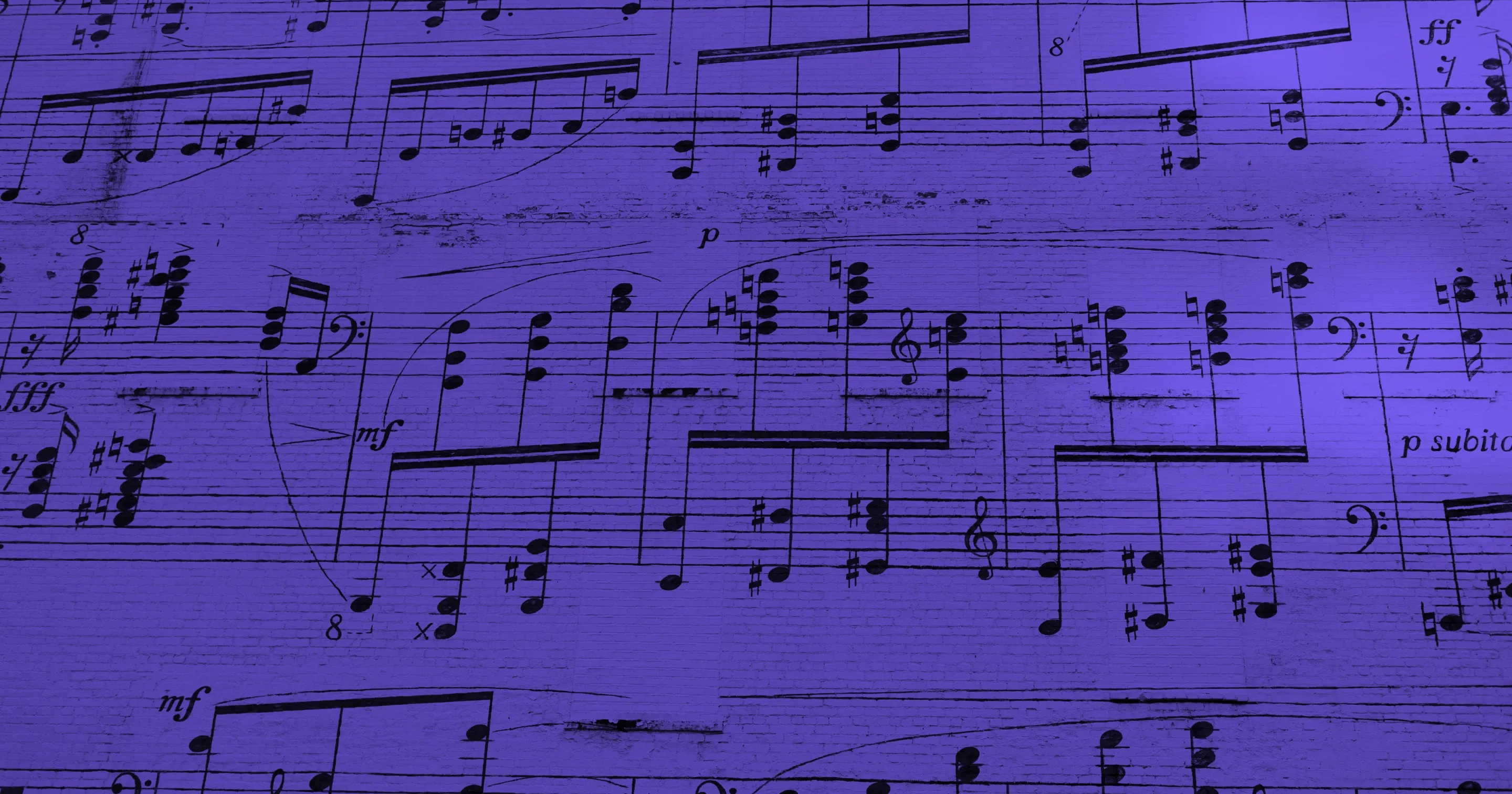
Learn Chords in G Minor: A Music Theory Guide
Learn about G Minor chords, and explore their role in music theory, and how to use them in your own compositions. Perfect guide for beginners and musicians
Introduction
Understanding chords and their interactions within a key provides a powerful tool for writing captivating and dynamic chord progressions in your music. In this guide, we'll examine the G Minor key signature, illustrating how to create engaging chord sequences that resonate with your audience.
We will begin by exploring the fundamentals of the G natural minor scale, subsequently delving into the triads and seventh chords that define G minor's distinctive character. Lastly, we will explore some intriguing non-diatonic chords that will significantly enrich your musical compositions.
Using practical illustrations, you will understand how to immediately implement these theoretical principles in your songwriting and music production endeavors.
The Basics of the G Minor Scale
We begin constructing chords in G Minor with its fundamental building block: the G natural minor scale. The G Minor scale comprises the notes G, A, Bb, C, D, Eb, and F, arranged according to a specific sequence of whole and half steps: W-H-W-W-H-W-W.

This specific pattern of whole and half steps is identical to the Aeolian mode, also known as the natural minor scale. The video by Charles Cornell is highly recommended for a more in-depth explanation of musical modes.
Each note within this scale possesses a specific function, a scale degree, determined by its interval from the tonic, G. These degrees and their corresponding Roman numeral designations are essential for understanding how chords operate within G Minor. These symbols enable us to outline chord progressions.
- G - Tonic (1st degree) - i
- A - Supertonic (2nd degree) - ii°
- Bb - Mediant (3rd degree) - III
- C - Subdominant (4th degree) - iv
- D - Dominant (5th degree) - v / V
- Eb - Submediant (6th degree) - VI
- F - Subtonic (7th degree) - VII
On our blog, you can find additional exploration of music theory concepts, including comprehensive guides covering all key signatures.
Harmonic Minor and Melodic Minor
Now, G Minor provides more than just the natural minor scale. We can modify it to create the harmonic and melodic minor scales, introducing distinct tonal qualities. The harmonic minor scale raises the seventh note, F, to F#, generating a"leading tone"that strongly pulls towards G, making resolutions feel more conclusive.
This F# is frequently used to create a major V chord (D major), even within natural minor progressions, to achieve that traditional V-i resolution.

The melodic minor scale functions differently. In its ascending form, it raises both the sixth and seventh notes (Eb and F) to E and F#, resulting in smoother melodic lines. In its descending form, it returns to the natural minor scale.

These two variations broaden the expressive possibilities of G Minor.
G Minor Chords and Their Functions in Music
The most basic chord, a triad, consists of three pitches stacked in thirds. These intervals of thirds can be either major or minor.
- Root: This is the fundamental note, the basis on which the chord is built, and it provides the chord with its name.
- Third: This interval determines the chord's quality, indicating whether it is major or minor. A minor third above the root creates a minor chord. A major third above the root creates a major chord.
- Fifth: This interval contributes harmonic depth and stability to the chord. The fifth can be augmented (raised) or diminished (lowered) by a half step.
From the G Minor scale, we derive seven diatonic chords: Gm, Adim, Bbmaj, Cm, Dm, Ebmaj, and Fmaj.
These chords are not arbitrary; they generate harmony and musical motion. Understanding their construction and function is crucial for composing engaging chord progressions in G Minor.

Let's explore these G Minor chords in practice, emphasizing their typical usage in progressions. The piano is an excellent tool for visualizing these chords, illustrating their construction and how alterations, such as those in augmented chords, modify their sound. By observing the chords on the keyboard, we can better grasp their function and how they create movement and emotion in music.
i: G Minor
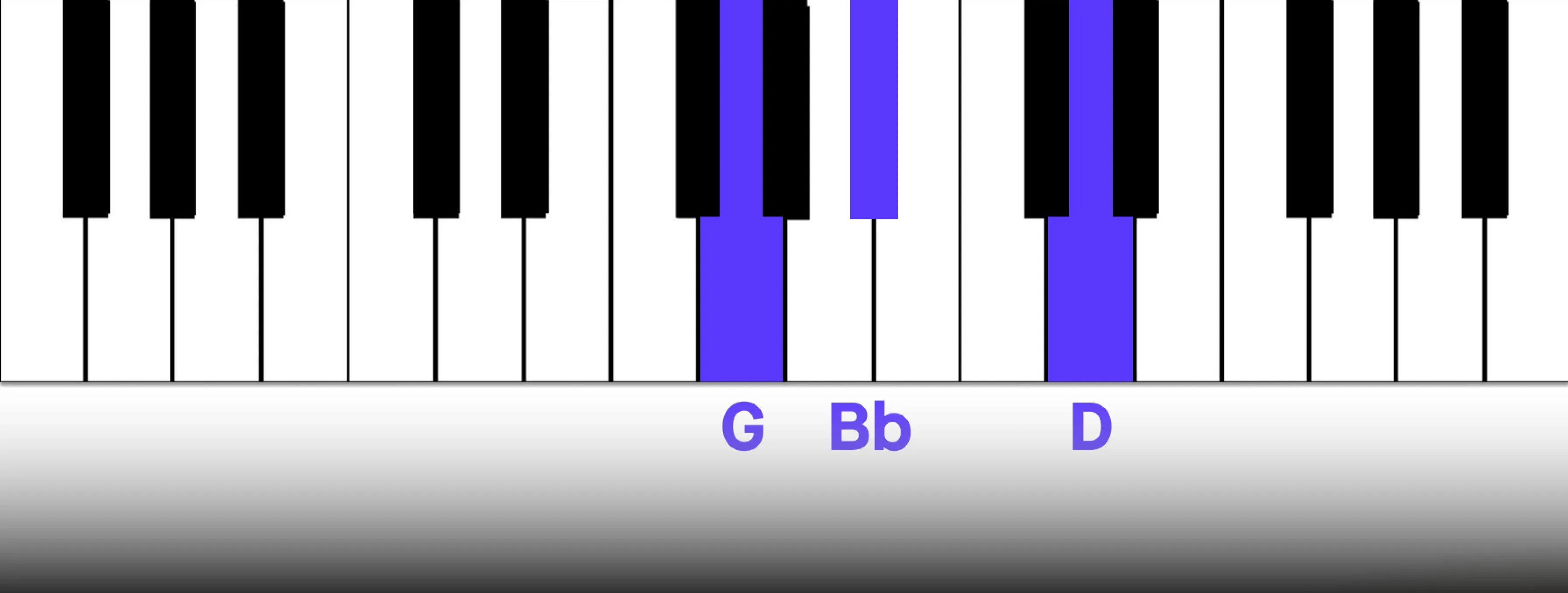
The G Minor chord, as the tonic, is the harmonic center of the key. It provides a feeling of stability and resolution. The tonic chord is the primary harmonic element, establishing the fundamental framework for all subsequent harmonic relationships.
t acts as the reference point for harmonic tension and release, while providing context for all harmonic events within the key. Chord progressions commonly use the tonic chord to establish and reinforce the tonal center, often employing it at the start and end of musical phrases or sections, thereby creating a sense of harmonic closure.
Example: Deep Purple's iconic"Smoke On The Water"firmly establishes its G minor tonality through both its verses and chorus. The verse predominantly anchors itself to the tonic, with occasional shifts to the subdominant providing brief harmonic color.
The chorus introduces a contrasting motion, starting on the subdominant before moving to the chromatic Neapolitan chord (Ab major, functioning as a bII). This unexpected harmonic progression then resolves back to the stable tonic, which, after a chromatic chord, feels even more stable.
ii° - A diminished
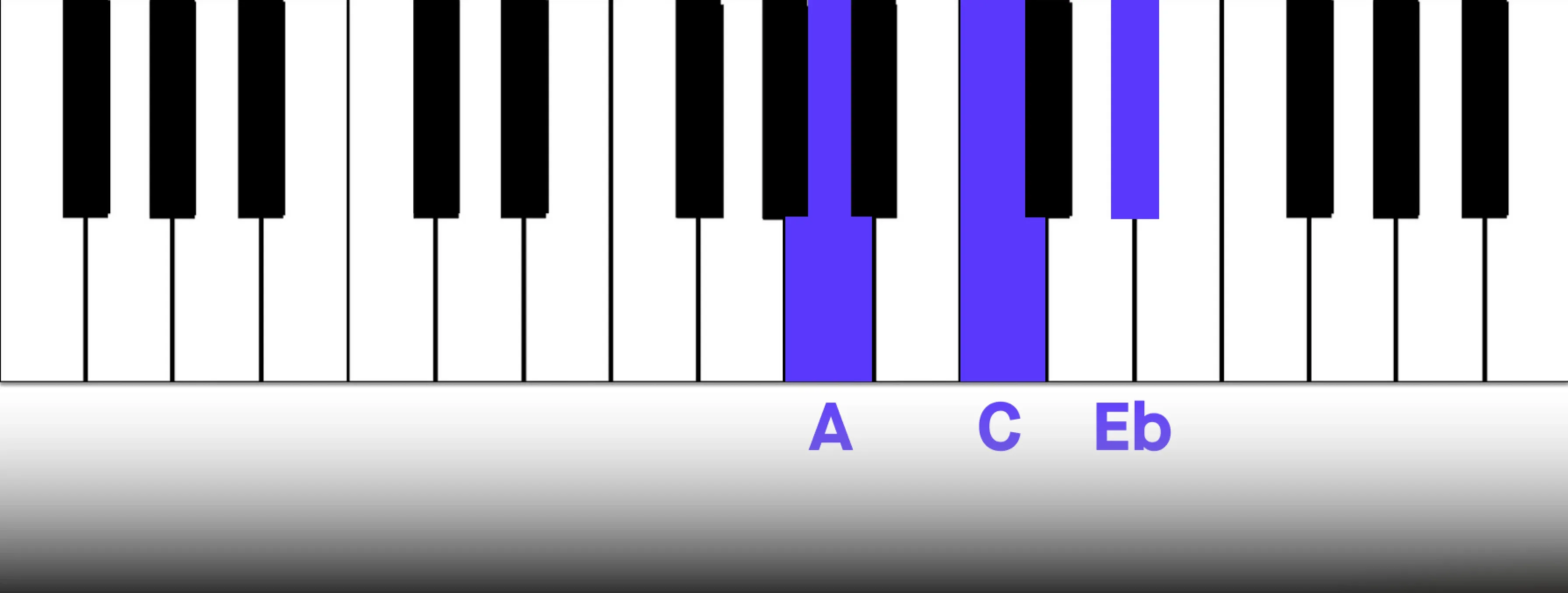
The diminished chord, with its inherent instability, offers a crucial source of harmonic tension and color. One of the primary roles of the supertonic chord is to act as a link, enabling smooth transitions to either the dominant or the tonic.
This dual function allows for subtle expressive possibilities. When resolving to the tonic, it provides a gentle yet expressive return following harmonic exploration. Its unique combination of minor and diminished qualities adds a distinctive, rich color, propelling the harmonic progression forward with dramatic effect.
Given the inherent dissonance of diminished chords, they are often substituted with more consonant harmonies to create a smoother progression. An example of this can be heard in the bridge of The Beatles'"Here There and Everywhere".
While the bridge modulates to G minor, it features an Am7 chord functioning as the supertonic in that key. This choice establishes a harmonic link to the preceding G Major section, where A minor is a diatonic ii chord. The use of the Am7 in the minor key retains the supertonic function, offering a richer and more stable sound compared to a diminished triad.
III: Bb Major
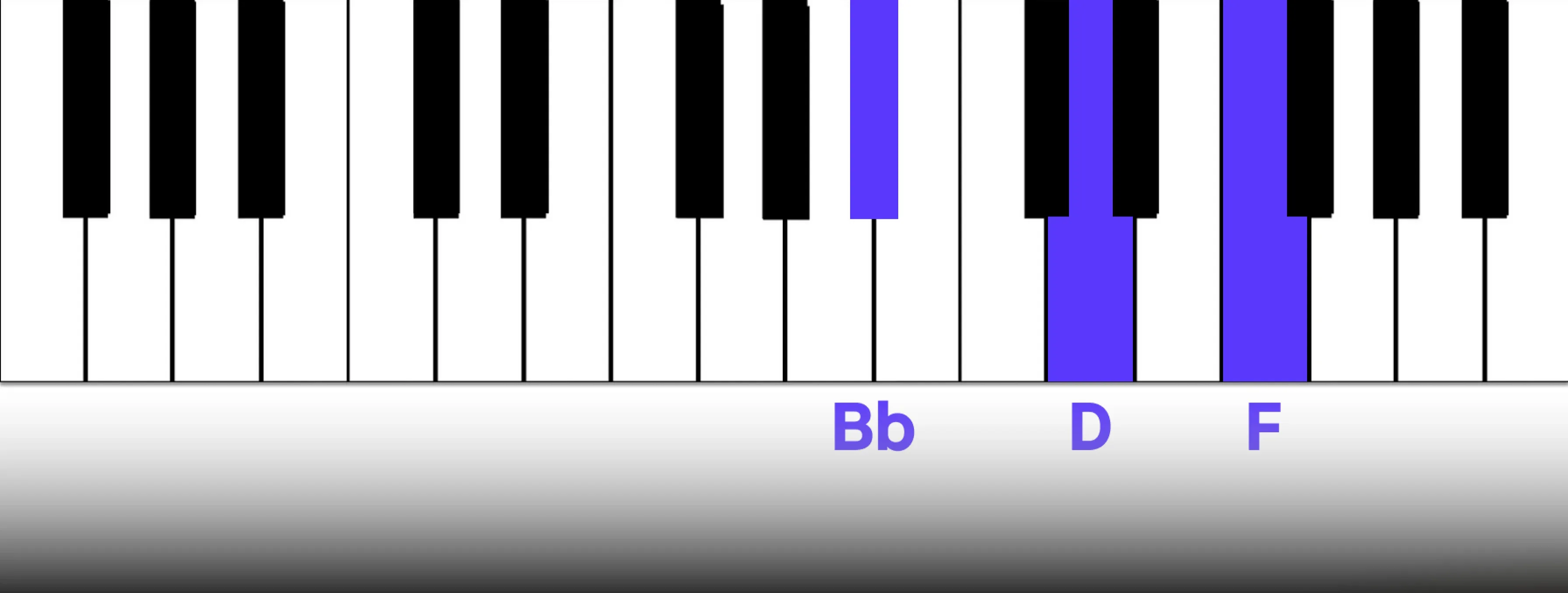
The Bb major mediant chord introduces a distinct and contrasting color to the G Minor tonality. It offers a more nuanced harmonic tension, suggesting resolution while often leading to unexpected harmonic paths.
This chord functions as a versatile harmonic element, serving as a passing chord, creating contrast with primary minor chords, and acting as a substitute for the tonic.
The mediant chord in a minor key is also the tonic of the relative major key signature. Therefore, the Bb major chord allows for a sense of connection and potential temporary shifts in tonal center.
Example: Seal's"Kiss From A Rose"is in G Minor, but it opens on the subdominant chord, which then progresses to the subtonic chord. This initial movement creates a sense of harmonic ambiguity, delaying the establishment of the tonic. The feeling of resolution and tonal grounding only arrives when the G minor chord finally appears, placing the preceding harmonies within their intended minor key context.
iv: C Minor
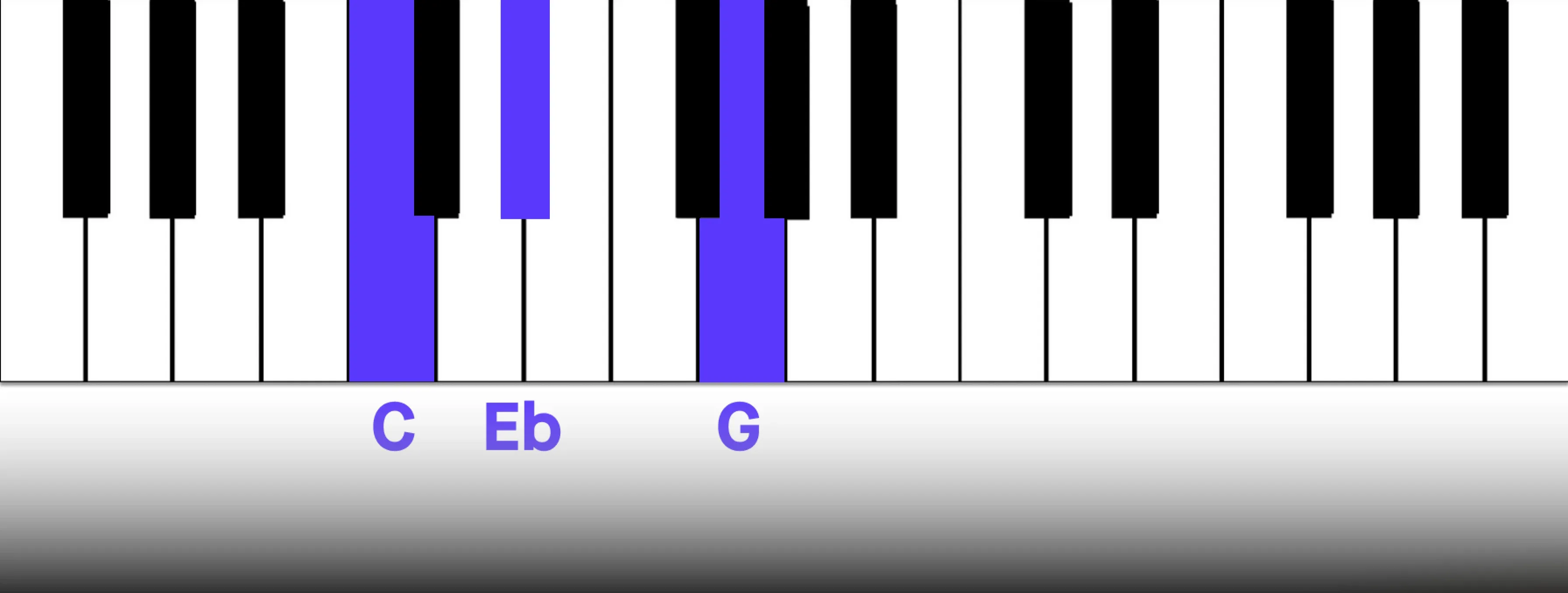
The subdominant chord, Cm major, plays a significant role in establishing harmonic motion and providing contrast within the key of G Minor. It offers a gentle departure from the tonic, creating a temporary point of harmonic interest.
In contrast to the dominant's strong tendency towards resolution, the subdominant generates a more subtle sense of anticipation and forward momentum. Its characteristic progression towards the dominant chord, which typically resolves to the tonic, represents a fundamental principle of tonal harmony.
Beyond its function within the basic i-iv-V-i progression, the subdominant enriches the harmonic landscape, introducing color and depth. It contributes to a sense of harmonic “departure and return”, thereby enhancing the overall musical experience.
Example: The chorus of t. A. T. u.'s"All About Us"is primarily built around a back-and-forth between the tonic and subdominant chords. This harmonic movement effectively highlights the contrasting characters of these two chords: the tonic provides a sense of stability and resolution, while the subdominant introduces harmonic color and departure from that stability. This motion creates a compelling push and pull, contributing to the chorus's emotional impact.
V: D Minor / D Major
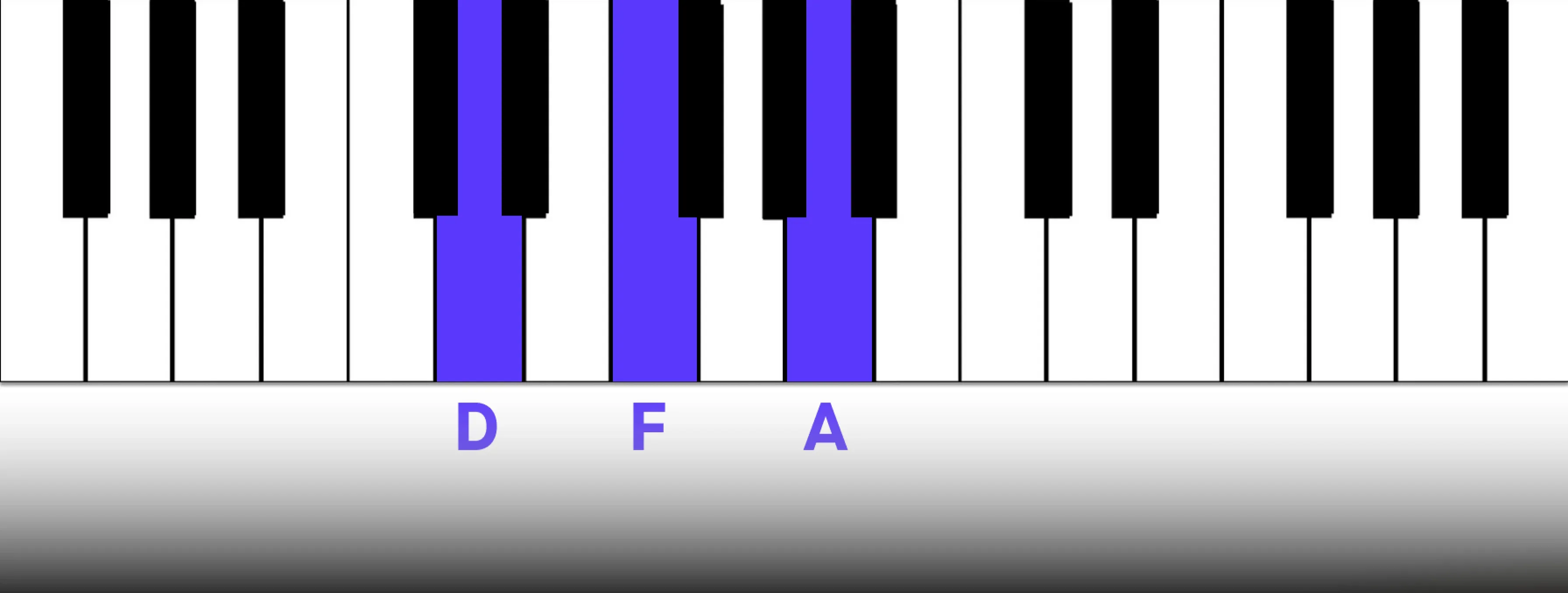
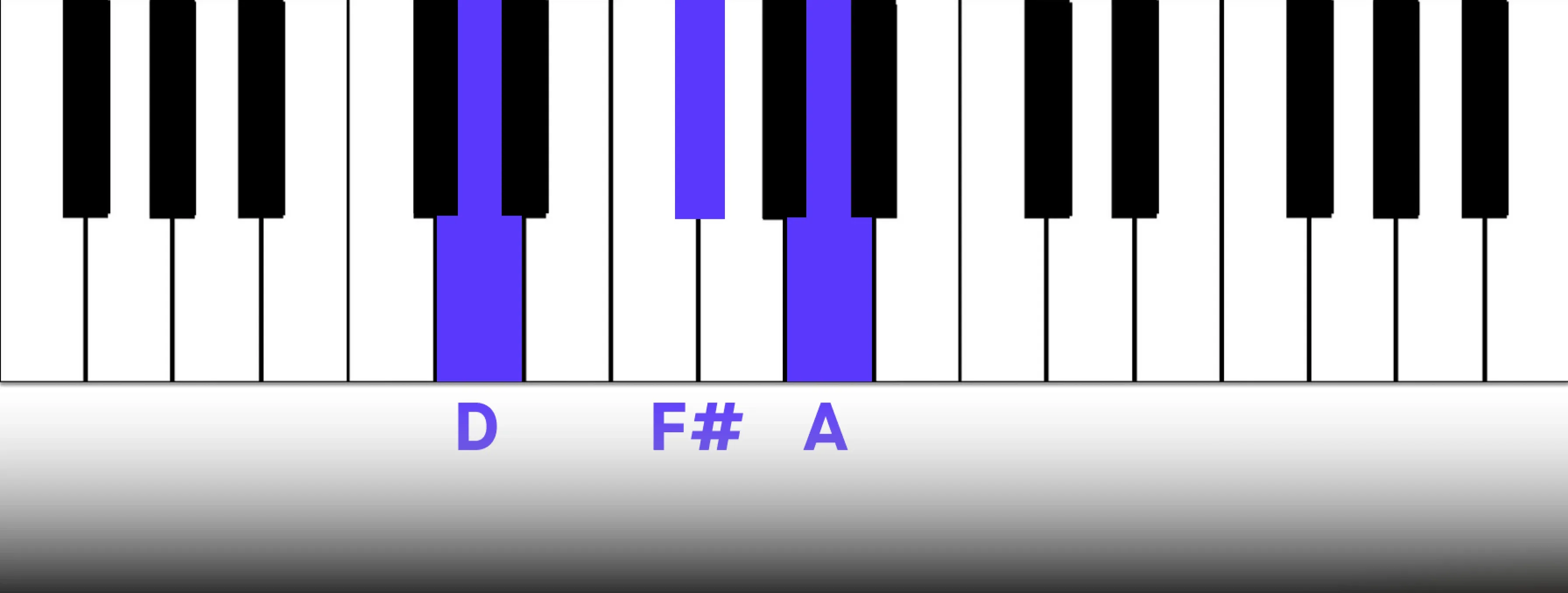
As we’ve seen, the diatonic dominant chord within a minor key is a minor triad. However, a common and crucial alteration involves raising its third, changing it into a major chord.
The dominant D major (or D7) chord assumes a central role within minor tonality. This chord embodies the highest degree of harmonic instability, propelling the musical narrative back toward the stability of the tonic, creating a sense of return and finality.
When heard within a minor key context, the major dominant chord possesses a brighter sonic quality and a heightened sense of tension. These attributes generate a compelling anticipation and a strong desire for immediate harmonic resolution.
The dominant's function is fundamental in defining the key and establishing a clear sense of harmonic direction for the listener.
While the dominant triad alone exerts a considerable pull towards resolution, the addition of a minor seventh interval above the root, forming a dominant seventh chord (D7), dramatically amplifies this sense of gravitational pull, rendering the subsequent return to the tonic even more conclusive and satisfying for the ear.
Beyond its fundamental role in resolution, the dominant seventh chord unlocks a powerful harmonic tool: secondary dominants. These chords function by temporarily treating a diatonic chord as if it were the tonic of its own key, creating a brief and compelling pull towards it.
By borrowing the dominant seventh chord from that implied key, you introduce a momentary shift in the perceived tonal center, adding layers of harmonic color and sophistication to your progressions. This technique injects heightened interest and a sense of harmonic motion beyond the straightforward diatonic relationships of the primary key.
Example: The song “Do I Wanna Know” by Arctic Monkeys uses the major dominant chord to add extra tension to the chord progression each time it is repeated.
VI: Eb Major
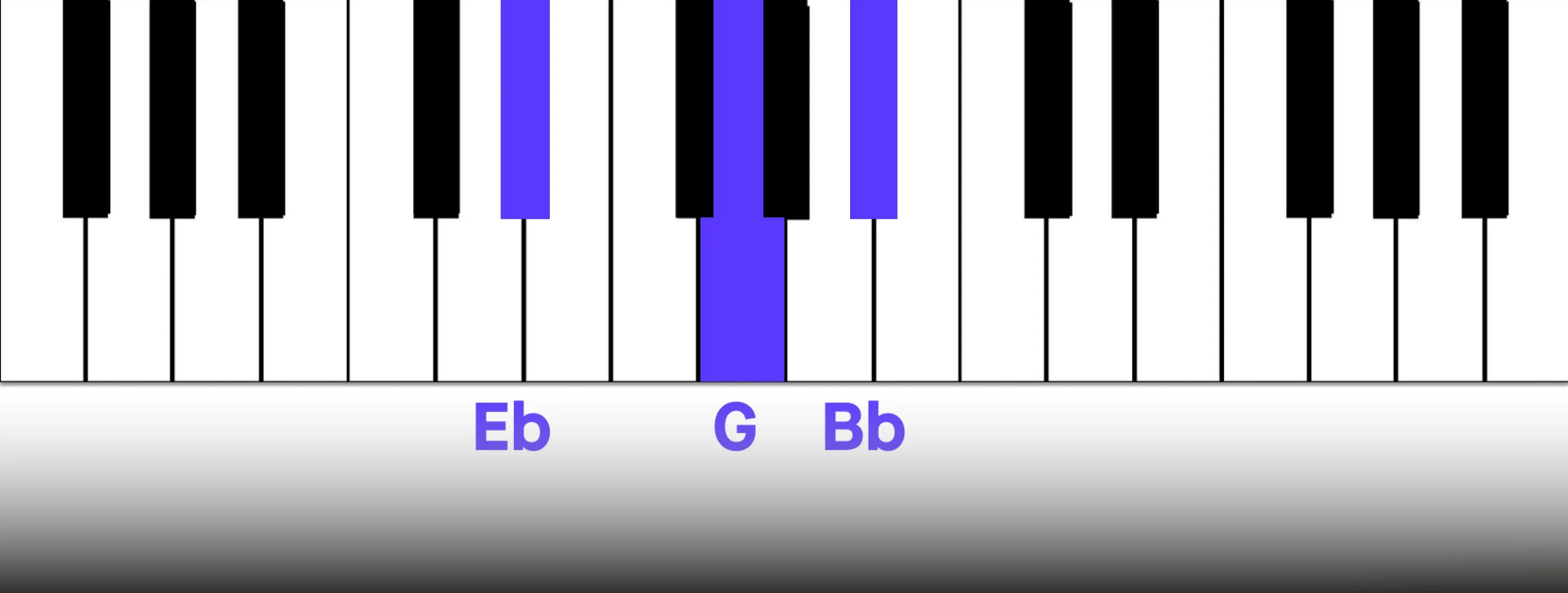
Due to its major quality, the Eb major chord introduces a unique harmonic contrast with the minor key. This creates a noticeable moment of harmonic color and can evoke feelings of reflection or a brief shift in the emotional landscape.
While it doesn't exert the same strong pull towards resolution as the dominant or the foundational support of the subdominant, the submediant plays a vital role in adding harmonic richness and complexity to a chord progression.
Its versatile nature allows it to function effectively as a passing chord, smoothing transitions between other chords and adding harmonic interest. It can also serve as a point of emotional emphasis, providing a moment of harmonic weight or broadening the emotional scope before the progression returns to more stable chords within the key of G Minor.
Example: In Avicii’s “Hey Brother”, the submediant chord is used prominently in the verse progression. This chord shares two notes with the tonic, providing a sense of harmonic stability that is closely related to the tonic, while still propelling the song forward.
VII: F Major
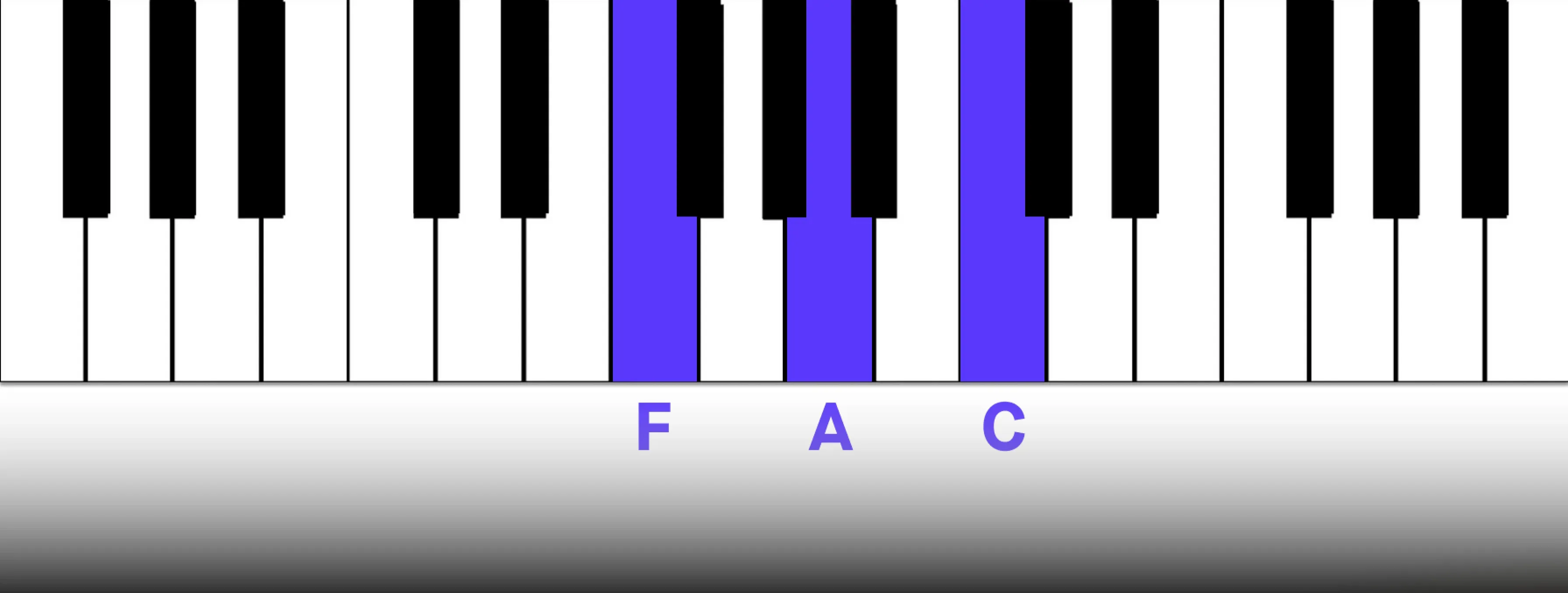
The F major chord, functioning as the subtonic within the G Minor tonality, plays a unique and often poignant harmonic role. It is characterized by its inherent lack of a leading tone to the tonic. Unlike a typical dominant chord, it doesn't create a strong pull towards resolution but offers a subtle sense of melodic and harmonic anticipation.
This characteristic arises from its position a whole step below the tonic. Rather than creating strong tension, it often serves as a passing chord or a moment of gentle harmonic color leading towards other chords, including the tonic. It can evoke a feeling of longing or a suspended resolution.
The F major chord in G Minor provides a distinct harmonic flavor, introducing a touch of melancholy or a sense of unresolved expectation. Its role is not to forcefully drive towards the tonic, but rather to create a unique harmonic color and contribute to a more nuanced emotional landscape within the musical progression. It can often lead to the tonic in a less direct, and therefore sometimes more evocative, way.
Example: Both “Kiss From A Rose” and “Hey Brother” use the VII chord as the final chord before returning to the tonic. This is common in pop and rock music. The subtonic chord naturally leads to the tonic, but without the inherent tension of the dominant chord.
These seven diatonic chords create a strong base for crafting interesting progressions in G Minor. For ideas on your next song, look at “30 Unique Songwriting Prompts to Craft Your Next Big Hit".
Adding Depth and Complexity to Chords in G Minor
Seventh chords enhance the depth and richness of G Minor, producing more intricate and emotionally resonant sounds. They are constructed by adding another third above the fifth of a triad, essentially stacking four notes instead of three. Here are the primary types you'll encounter in G Minor:
- Major 7th: A major triad with a major seventh interval added above the root. It often evokes a sense of gentle resolution with a subtle, beautiful lingering tension.
- Minor 7th: A minor triad with a minor seventh interval added above the root. This chord frequently creates a smooth, introspective, or melancholic atmosphere.
- Dominant 7th: A major triad with a minor seventh interval added above the root. This chord is characterized by its strong internal tension and a powerful desire to resolve back to the tonic, propelling the musical movement forward. The tritone interval within the chord is the source of this tension.
- Half-diminished 7th (m7b5): A diminished triad with a minor seventh interval added above the root. It possesses a unique blend of tension and ambiguity, creating a distinct and often intriguing sound.
Incorporating seventh chords into your chord progressions adds a layer of sophistication and emotional depth. They bring out richer harmonic colors and nuances in your music.
For a more detailed guide on Seventh Chords, look at our article “A Comprehensive Guide on Creating Seventh Chords in G Minor “.
In the next section, we will look at both the diatonic (within the key) and chromatic (outside the key) chords available in G Minor, complete with accompanying audio examples and musical notation.
For individuals unfamiliar with reading music, we highly recommend exploring a beginner's music theory resource, such as Music Matters' Grade 1 Music Theory course available on YouTube.
The Diminished Chord
Diminished chords possess a distinctive, tense sonic character. They are constructed by stacking a minor third and a"diminished fifth"(an interval a half-step smaller than a perfect fifth) above the root. This diminished fifth creates a tritone, a highly dissonant interval, which gives the chord its unstable and often edgy quality.
This inherent tension makes diminished chords exceptionally expressive. They can introduce feelings of suspense, unease, drama, or heightened intensity into your music. Due to their unresolved nature, they generate a strong sense of pull towards the subsequent chord, making any subsequent resolution feel particularly impactful.
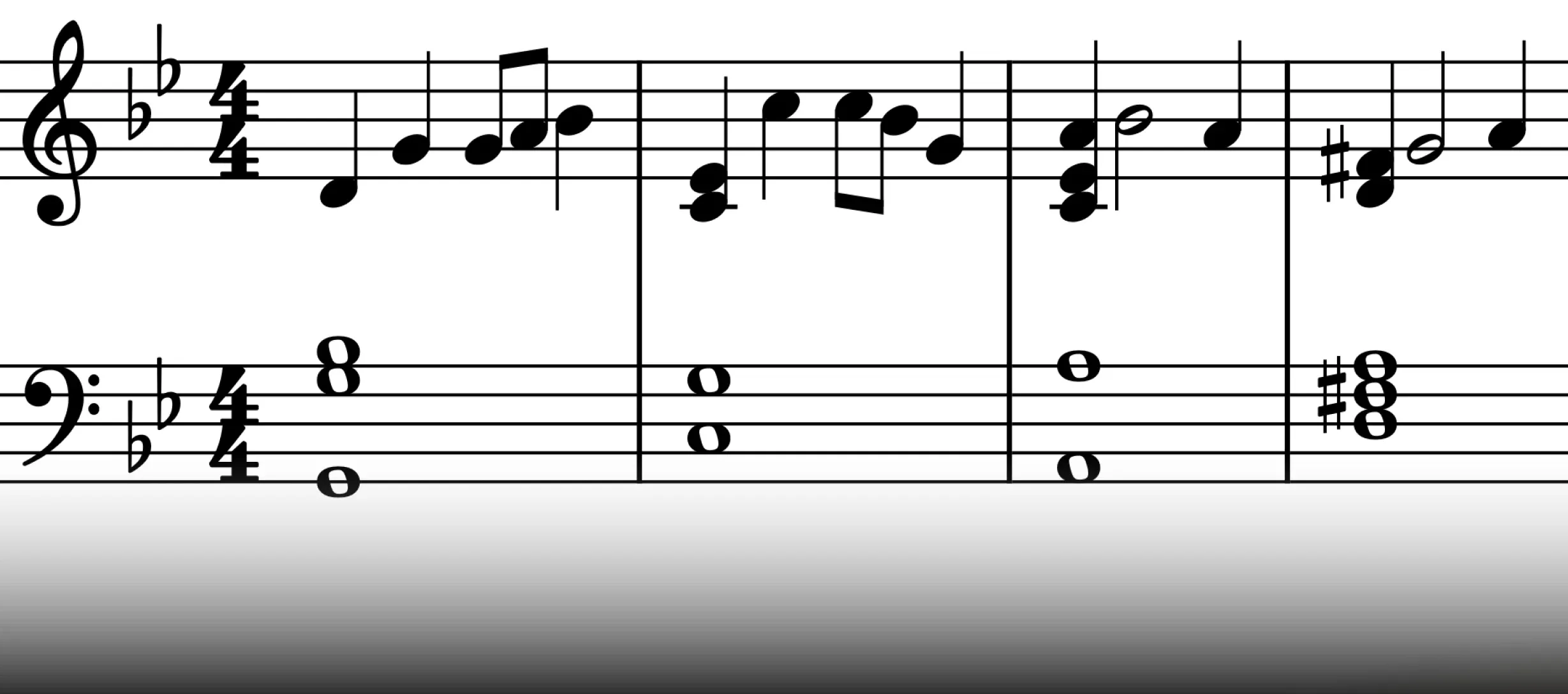
Chords: Gm - Cm - Adim - D11
Natural Occurrence Within Minor Scales
Within the fundamental chords of G Minor, only one diminished chord arises naturally. To construct diminished chords on other notes of the G Minor scale, we must employ chromatic notes – notes that lie outside the standard G Minor scale. This signifies a temporary departure from the usual harmonic boundaries of the key to achieve that specific sonic effect.
Functions of Diminished Chords
Diminished chords are a common element in jazz harmony, where they are utilized to generate tension and subsequent release, adding rich harmonic colors and complexity to progressions. While less frequently encountered in pop and rock music, they still offer significant expressive possibilities. Here's how they can be employed:
- Creating Tension: Their dissonant sound, resulting from the tritone interval, produces instability, thereby intensifying the impact of the following resolution.
- Facilitating Smooth Transitions: They often serve as passing chords, providing a smooth harmonic link between other chords within a progression.
Beyond these fundamental applications, diminished chords can introduce unique flavors to your progressions:
- Diminishing Existing Chords: Transforming a conventional major or minor chord into a diminished one can create a moment of harmonic tension and surprise for the listener.
- Chromatic Movement: Utilizing diminished chords to move chromatically between two other chords can introduce intriguing harmonic motion and color.
These techniques empower you to introduce harmonic depth and intrigue into your compositions within the key of G Minor.
The Augmented Chord
Augmented chords have a characteristic, dissonant sound, constructed by stacking two major thirds. As they do not occur naturally within the key of G Minor, we must incorporate notes outside the scale to create them.
Alongside other chromatic alterations, augmented chords bring complexity, tension, and a sense of movement to your music. They can generate surprising harmonic shifts and create a compelling drive towards resolution.
They offer a diverse palette of expressive possibilities, ranging from unexpected harmonic twists and smooth transitions between tonal centers (functioning as"pivot chords") to simply adding unique color and variety to your sonic landscape.
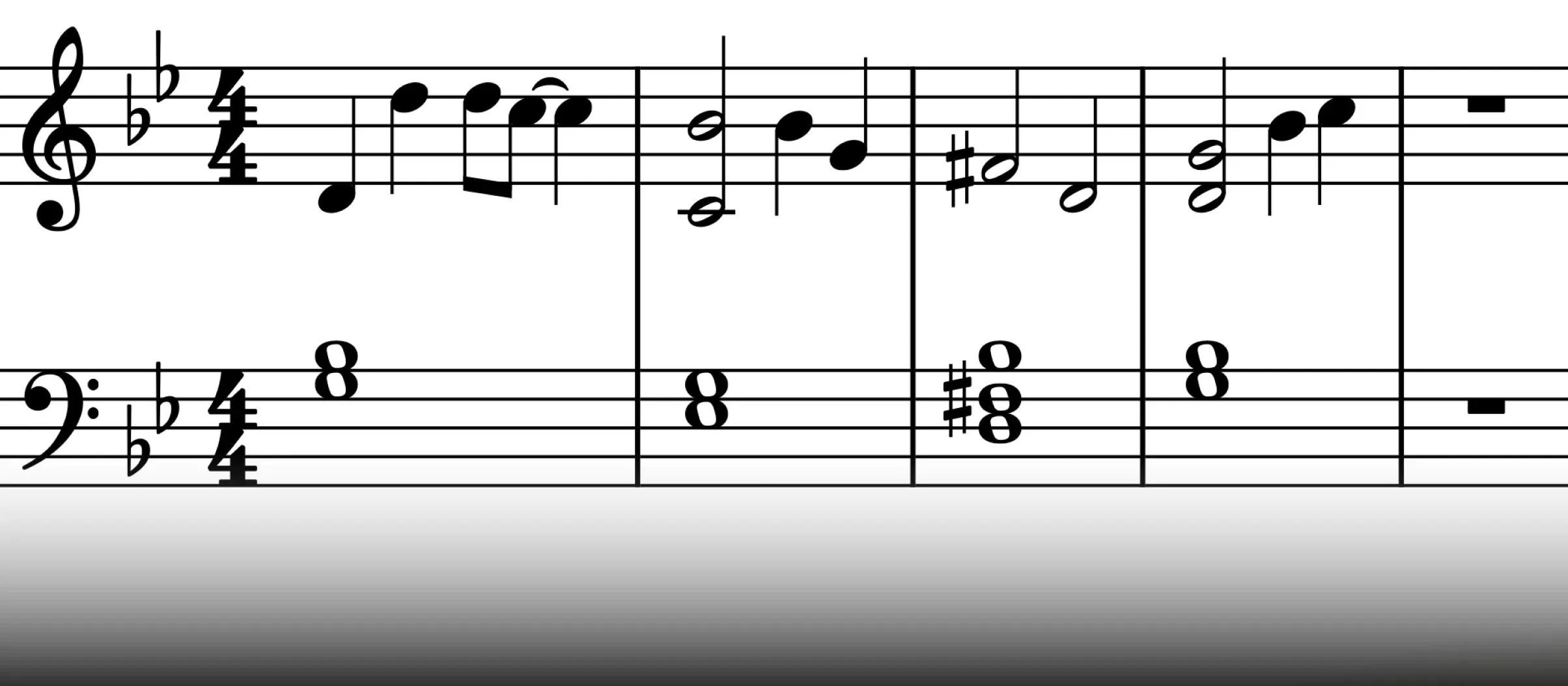
Chords: Gm - Cm - Daug -Gm
Below are a few common ways augmented chords are used in chord progressions.
- Dominant to Tonic: An augmented V chord resolving to i creates a strong and emphatic sense of arrival and closure.
- Tonic to Subdominant: An augmented tonic progressing to the subdominant offers an intriguing harmonic contrast, where the initial instability resolves to a less final, yet harmonically interesting, release.
- Line Clichés: Incorporating augmented chords within stepwise melodic or bass lines adds harmonic tension and depth to these linear movements within the context of G minor progressions.
Despite their inherently unstable sonic character, augmented chords fulfill crucial functions within the harmonic landscape.
- Smooth Voice Leading: They facilitate connections between chords through chromatic (half-step) or stepwise (whole-step) movement of individual notes, creating smoother transitions.
- Tension and Release: Their dissonant quality builds harmonic tension, making the subsequent resolution to more stable chords within G minor feel more impactful and satisfying.
- Key Changes (Modulation): Their inherent ambiguity allows them to function as pivot chords, providing smooth transitions to related keys by sharing common tones that belong to both the original and the new key. This allows for seamless movement away from and potentially back to G minor.
Suspended Chords: Expanding Beyond Major and Minor
Suspended chords, often abbreviated as"sus"chords, introduce a sense of harmonic ambiguity. They achieve this by replacing the crucial third interval of a standard triad with either the second or the fourth degree of the G minor scale, resulting in"sus2"or"sus4"chords, respectively.
By omitting the third, which fundamentally determines whether a chord is major or minor, a feeling of unresolved tension – a"suspension"– is created. This characteristic makes sus chords sound less harmonically defined than typical major or minor chords, lending them a unique and open sonic quality.
This open sound is versatile for expressing a broad spectrum of emotions. Sus chords evoke dreamy, ethereal atmospheres, build a sense of suspense and anticipation, or introduce harmonic interest and variation to progressions within the key. Their anticipatory nature allows for nuanced emotional expression, broadening your musical vocabulary.
Suspended chords serve several key roles:
- Building Anticipation: They naturally generate harmonic tension and anticipation, making them ideal for creating transitions between chords and building intensity within musical phrases.
- Adding Harmonic Color: Their unique intervallic structure introduces subtle variations and harmonic depth to progressions, helping to avoid monotony and adding richness.
- Prolonging Dominant Tension: The Vsus4, based on the dominant chord, is particularly effective for extending the tension of the dominant function before resolving to the tonic, making the V-i resolution feel even more conclusive and satisfying.
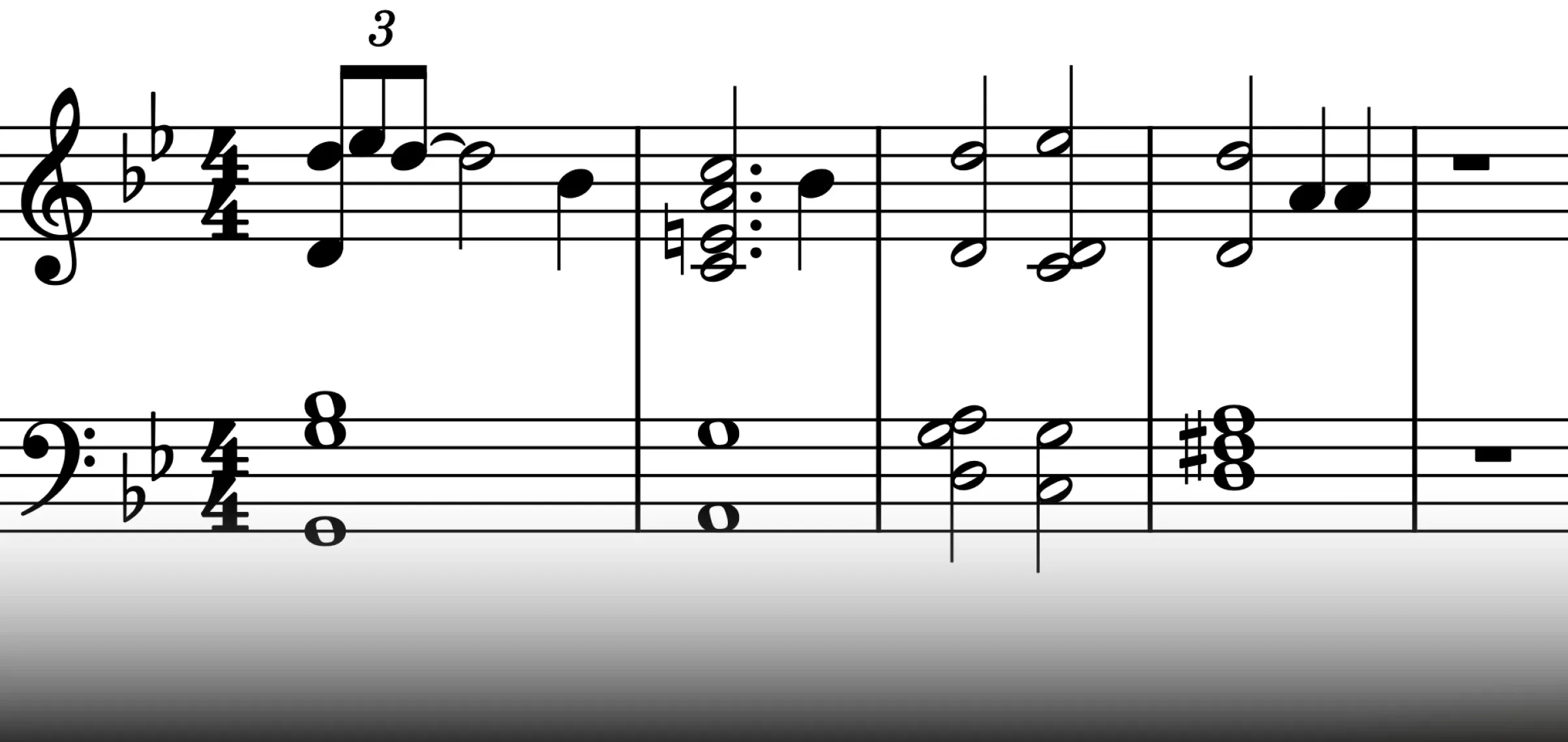
Chords: Gm - Am7 - Dsus4 - Csus2 - D
While suspended chords introduce unique color and complexity, their emotional impact is highly dependent on the surrounding musical context – the accompanying harmonies, the instrumentation employed, and the overall tempo of the piece.
For instance, a sus4 chord in a slow and deliberate passage might evoke a feeling of yearning or unresolved longing. In contrast, the same chord in a faster tempo could contribute to a sense of building anticipation and forward momentum.
The sus2 and sus4 chords differ in their tendency towards resolution. The sus4 chord, containing a perfect fourth interval above the root, often strongly pulls towards resolving to the major or minor third of the chord it’s built upon.
At the same time, the sus2 chord, featuring a major second interval above the root, generally possesses less inherent tension and can often feel more harmonically independent or resolve less predictably.
A thorough understanding of suspended chords provides you with a robust set of tools for enriching your chord progressions. They offer the ability to add depth, unique color, and a sense of intrigue to your harmonic language, regardless of the specific genre you’re writing in.
Power Chords
Power chords can provide a raw, foundational energy to music. These simplified chords, consisting primarily of the root and the perfect fifth (often with an octave doubling), can deliver a punchy and versatile sonic impact. This stripped-down structure can create a powerful, direct sound that can be useful for rhythmic emphasis or foundational harmonic movement.
The absence of the third interval is key to the nature of power chords. This omission creates a tonally ambiguous sound that can function within various melodic and harmonic frameworks. This simplicity allows them to be integrated into different musical settings, from driving rhythmic figures to underlying harmonic support.
Furthermore, omitting the third can be beneficial when using a distorted guitar, the staple of rock chord progressions. Distortion, while adding intensity and grit, can also accentuate any harmonic clashes. By focusing on the root and fifth, these simplified chords can avoid unwanted dissonance when subjected to heavy distortion.
Chord Inversions
Chord inversions happen when the lowest note of a chord is no longer its root. This seemingly minor adjustment can significantly change the character of the chord. The bass note has a substantial impact on harmonic stability and our overall perception of the sound.
Specifically:
- First Inversion: The third of the chord is in the bass. For a Gm chord, this would have Bb as the lowest note.
- Second Inversion: The fifth of the chord is in the bass. For a Gm chord, this would have D as the lowest note.
- Third Inversion: The seventh of the chord is in the bass (only for seventh chords). For a Gm7 chord, this would have F as the lowest note.
These inversions can fundamentally alter the sonic landscape of a chord progression within the key. They facilitate smoother transitions between chords, introduce harmonic variety, and enhance musical interest. Beyond just changing the sound of individual chords, inversions provide ways to build more sophisticated and nuanced chord sequences.
To hear this difference, let's compare two versions of the same progression in the minor key. The first uses all root position chords, creating a stable, grounded feeling. The second version uses inversions for most chords.
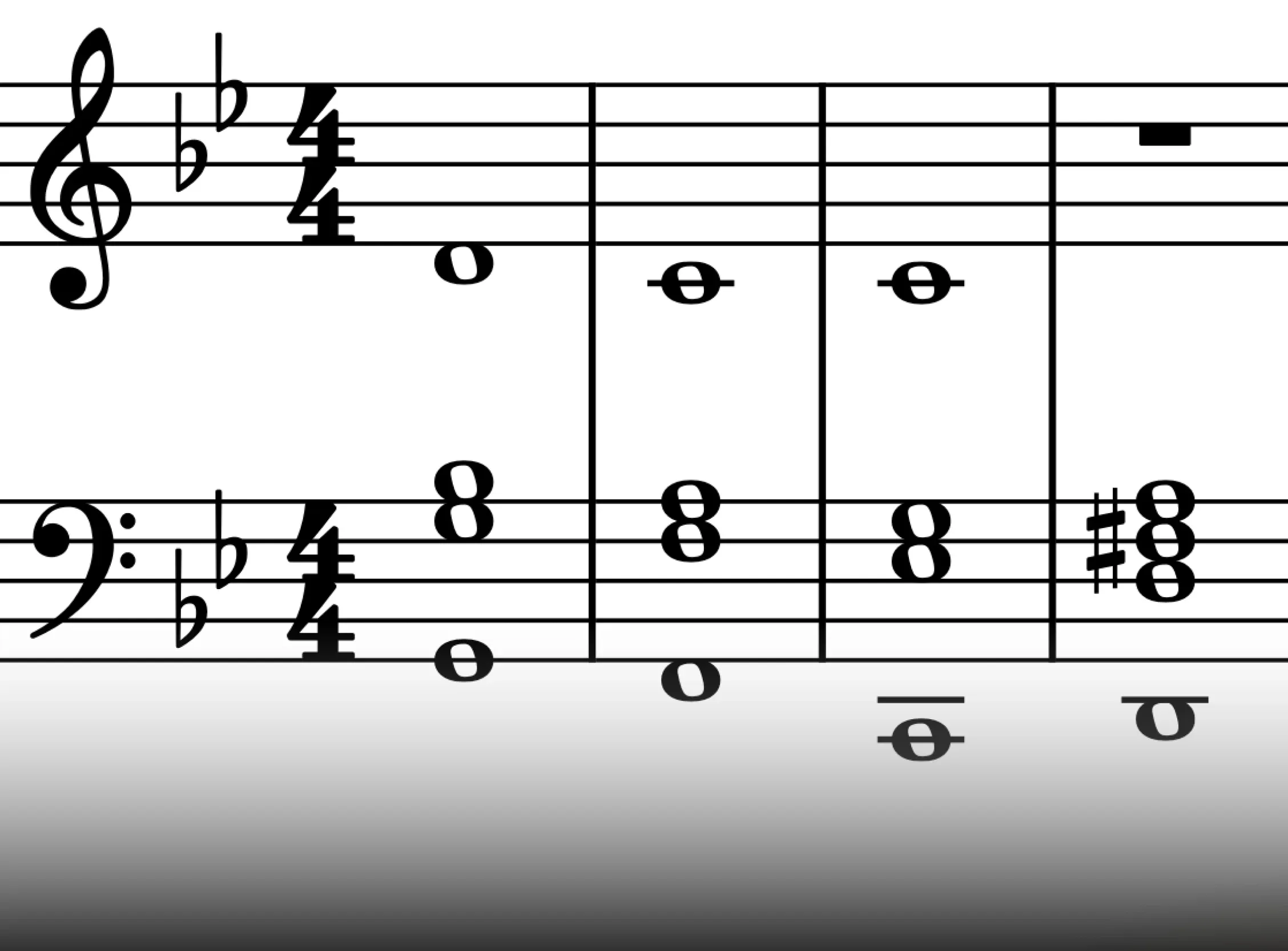
Chords: Gm - F - Cm - D (all in root position)
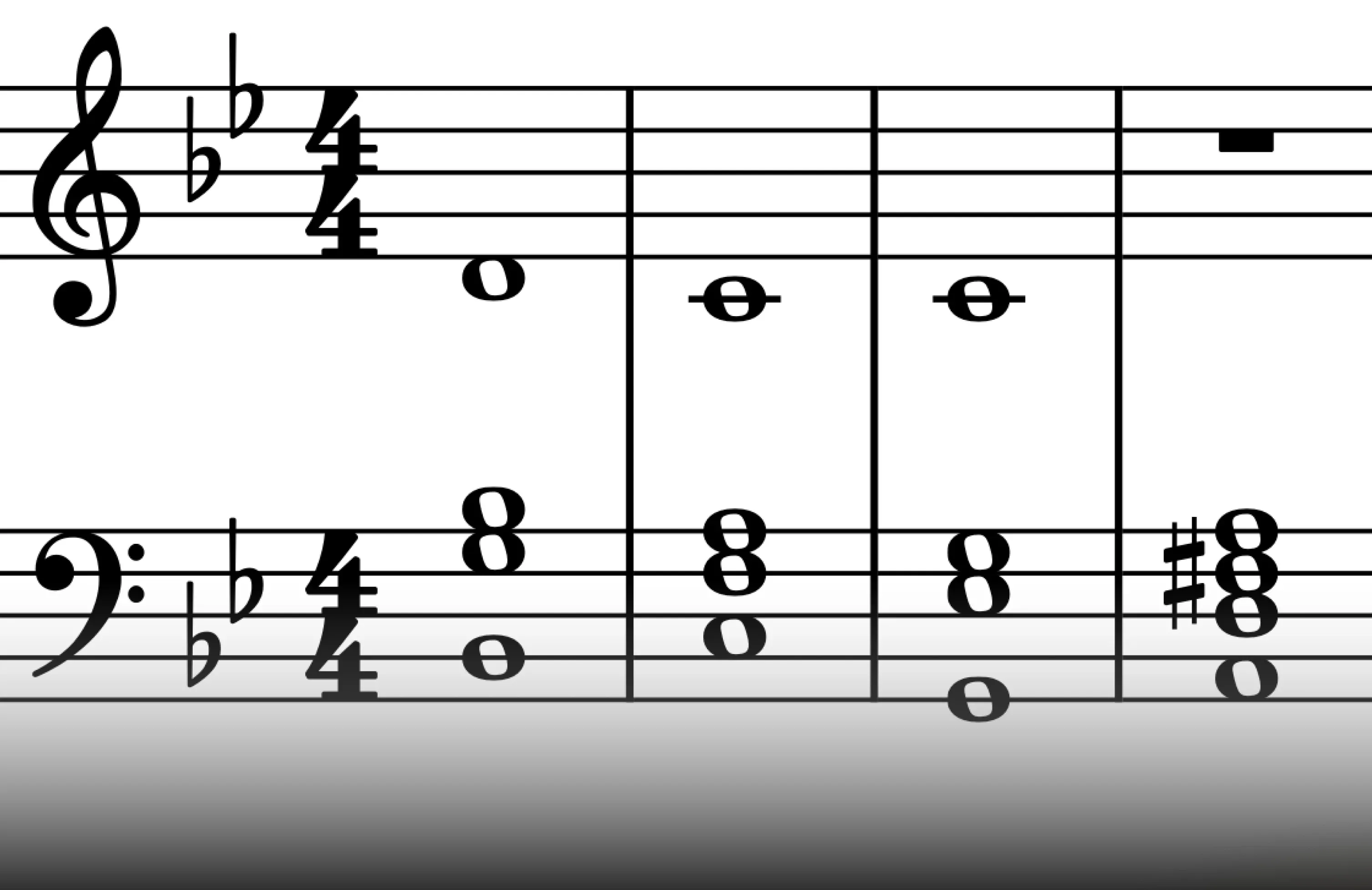
Chords: Gm/Bb - F/C - Cm/G - D/A
While the bass note determines a chord's inversion, the arrangement of the remaining notes — known as voicing — significantly influences its sonic character and emotional impact. The intervals between these upper notes contribute to the chord's unique color and texture.
Even when a chord's inversion remains the same (for example, a G minor chord with Bb in the bass), altering the arrangement of the G and D above it will affect its specific sound and how it resolves to the next chord. Inversions themselves can be beneficial in achieving smooth voice leading, which refers to the seamless movement between consecutive chords.
For musical ensembles, careful attention to voice leading is essential. Minimizing large intervals between the same voices in successive chords and avoiding dissonant clashes can help achieve a more cohesive and pleasing overall sound within a progression.
Stability and Sound
Chord inversions subtly shift a chord's stability and sonic character by changing the intervals created between the lowest note and the other notes of the chord. This technique allows for expressive depth and harmonic variety without introducing unwanted dissonance.
Chords in root position, with their root note in the bass, sound stable and grounded. In contrast, inverted chords, having a note other than the root in the bass, can create a sense of harmonic motion or a feeling of being less settled, offering harmonic interest without harshness.
Experimenting with inversions of the tonic chord can be a valuable way to add subtle nuances of stability and reinforce the feeling of "home" within a musical piece. Different inversions possess varying degrees of stability, allowing for fine-tuned control over the perceived level of resolution.
Beginning or ending musical phrases with inverted chords can add a sense of refinement and prevent the music from sounding too static, thus enhancing the overall harmonic flow.
For example, you might start a progression with the tonic chord in root position to establish a firm foundation and then use inversions to vary the sense of stability while keeping the chord's fundamental tonality.
This approach introduces harmonic interest while reinforcing the key. Inversions contribute significant, subtle detail and richness to musical textures. They open up possibilities for the bass line and provide diverse options for voicing chords, leading to more engaging and sonically interesting musical experiences in the minor key.
Learn How to Recognize Intervals
The ability to instantly recognize intervals is essential for confidently working with triads, inversions, and altered chords, such as diminished, augmented, and suspended voicings. This skill streamlines the songwriting process, enabling intentional harmonic choices and reducing guesswork when selecting chords or melodic notes within the minor key.
For example, upon hearing a melody ascend by a perfect fourth, immediate interval recognition allows for the identification of potential chord tones or the construction of suitable harmonies. Training your ear to distinguish intervals provides a significant degree of control over musical expression, leading to more efficient composition, informed harmonic decisions, and ultimately, more effective communication of musical ideas within the minor key.
For practical exercises, we recommend exploring our ear training article, which provides musical examples for practicing interval recognition in both ascending and descending directions. These exercises will help develop this crucial aural skill, allowing you to understand better the building blocks of harmony in the minor key.
How to Write Chord Progressions in G Minor?
With a solid understanding of the chords available in the minor key now in place, the next step is to apply this knowledge practically. Our article “Mastering Chord Progressions in G Minor: A Complete Guide” is a valuable resource for the next stage.
In this guide, we explore how chords in G minor are used in popular music by analyzing well-known examples. It provides a set of harmonic techniques to enhance songwriting. You’ll learn to effectively use both chords that naturally occur within the key and those borrowed from outside it, drawing inspiration from successful songs and their chord sequences.
Furthermore, you’ll discover how to introduce harmonic color and intrigue through techniques like substituting the tonic chord with related chords, using secondary dominant chords to create temporary pulls towards other tonal centers, employing chromatic mediant chords for unexpected shifts, and other methods for creating compelling harmonic changes.
The guide also addresses the concept of modulation, or changing key, empowering you to guide your listeners through engaging musical journeys.
Musiversal: Interactive Real-Time Collaboration with Professional Musicians
Elevate your musical productions through collaborative recording sessions with professional artists. With the Musiversal Unlimited subscription, you can access a limitless creative environment, featuring unlimited recording sessions and a network of over 80 professional musicians, songwriters, and engineers.
Transform Your Musical Concepts into Reality
Engage session musicians to realize the full potential of your musical compositions. By participating in live sessions via a dedicated link, you can collaborate with session drummers, string players, beatmakers, bassists, guitarists, vocalists, and more, ensuring that your artistic vision is faithfully executed.
You can schedule sessions at your convenience, join live, and experience the dynamic process of bringing your music to life.
Comprehensive Songwriting Support
Whether you have only the seed of an idea or a fully developed concept, Musiversal offers dedicated songwriting sessions. Our experienced songwriters will assist you with melodic development, harmony, lyric composition, and all other aspects of the songwriting process.
Professional Post-Production and Marketing
Our award-winning engineers provide expert mixing and mastering services to ensure your music is release-ready. Furthermore, our marketing specialists offer dedicated sessions to develop a comprehensive launch strategy, ensuring your music reaches its intended audience.
Musiversal Blog: A Comprehensive Music Resource
The Musiversal blog is updated weekly and provides expert insights on a wide range of topics, including music theory, songwriting, production techniques, equipment, and music marketing.
Your Music, No Limits.
Join the Waitlist